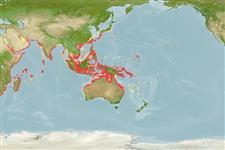Issue
nomen dubium: Sparks (2006) indicated that the designation of the lectotype(s) by Jones (1985) and Bauchot and Desoutter (1989) must be invalid because the lectotype was probably chosen from incorrect syntypes (see ICZN 1999: MNHN A.6738 with 2 specimens, MNHN A.6739, MNHN 1988-397, and MNHN 1988-328 measure too small, 26-46 mm SL, and are not correct syntypes). Valenciennes in Cuvier and Valenciennes 1835 stated clearly in the original description of Equula lineolata, ‘‘Nos individus sont longs de trois pouces (Our specimens are three inches in length)’’. Thus, the lectotype(s) designated are totally invalid, and it is impossible to identify Equula lineolata accurately for no type specimens could be found and the original description was incomplete (Ref. 120651).
Environment: milieu / climate zone / depth range / distribution range
Écologie
marin démersal; profondeur 20 - 50 m (Ref. 28016). Tropical; 36°N - 31°S, 30°E - 169°E
Indo-West Pacific: Durban, South Africa (Ref. 11228), Madagascar and Pakistan to the Philippines, north to southern Japan (Ref. 559), south to northeast Australia.
Taille / Poids / Âge
Maturity: Lm ? range ? - ? cm
Max length : 15.0 cm TL mâle / non sexé; (Ref. 5450)
Found in coastal waters. Stays near the substrate and feeds on fish, crustaceans, chaetognaths, nematodes, bivalves, and gastropods (Ref. 5213).
Life cycle and mating behavior
Maturities | Reproduction | Spawnings | Egg(s) | Fecundities | Larves
James, P.S.B.R., 1984. Leiognathidae. In W. Fischer and G. Bianchi (eds.) FAO species identification sheets for fishery purposes. Western Indian Ocean (Fishing Area 51). Vol. 2. FAO, Rome. pag. var. (Ref. 3424)
Statut dans la liste rouge de l'IUCN (Ref. 130435)
Menace pour l'homme
Harmless
Utilisations par l'homme
Pêcheries: commercial
Outils
Articles particuliers
Télécharger en XML
Sources Internet
Estimates based on models
Preferred temperature (Ref.
123201): 24.1 - 28.6, mean 27.6 °C (based on 318 cells).
Phylogenetic diversity index (Ref.
82804): PD
50 = 0.5010 [Uniqueness, from 0.5 = low to 2.0 = high].
Bayesian length-weight: a=0.00661 (0.00446 - 0.00978), b=3.18 (3.07 - 3.29), in cm total length, based on LWR estimates for this species (Ref.
93245).
Niveau trophique (Ref.
69278): 3.5 ±0.50 se; based on food items.
Résilience (Ref.
120179): Haut, temps minimum de doublement de population inférieur à 15 mois (K=1.05-2.83).
Fishing Vulnerability (Ref.
59153): Low vulnerability (13 of 100).
